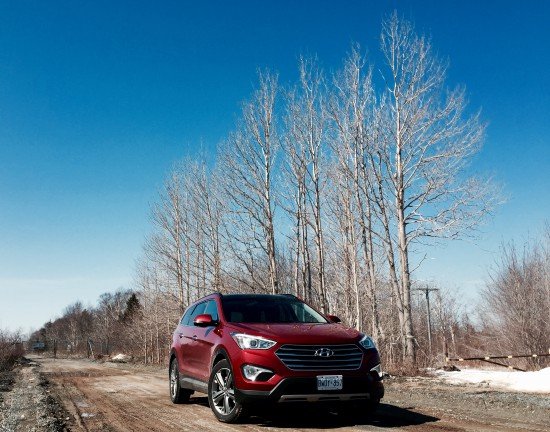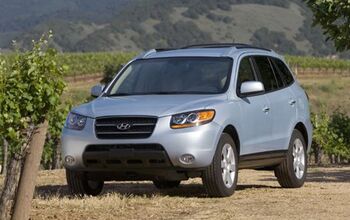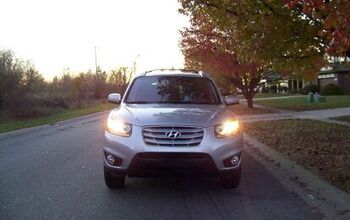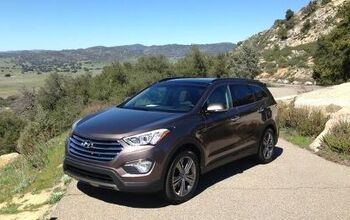2015 Hyundai Santa Fe Review – What, No Entourage?
Americans have spoken with their wallets and we can, for the most part, forget minivans. Consumers accept the loss of much of a minivan’s practicality and flexibility so long as their new vehicle still provides three rows of seats and gains a measure of all-weather usefulness.
• U.S. Market Price As Tested: $41,545
• Horsepower: 290 @ 6400 rpm
• Torque: 252 lb-ft @ 5200 rpm
• Observed Fuel Economy: 18.8 mpg
Exhibit A: the Hyundai Santa Fe, which is ostensibly a second-generation Hyundai Veracruz, a vehicle which joined many a three-row crossover in killing off vans like Hyundai’s own poorly named Entourage, which didn’t actually have an entourage of any kind. No following to speak of whatsoever.
Oh, there are still minivans. In 2015, Toyota will likely sell more than 150,000 Siennas in America for the first time since 2006. But total minivan volume is down 12% through the first-quarter of 2015 and minivans only accounted for 3.4% of all U.S. new vehicle sales in calendar year 2014, down from 6.5% a decade ago.
Perhaps you’ve decided that a minivan isn’t necessary, yet you’re not yet ready to lose all the practicality. You’re asking yourself, “How much seating flexibility do I need?” For those who answer, “Not all that much, actually,” Hyundai has a solution. Take the bigger seven-seat Santa Fe, not the Santa Fe Sport, and allow passengers to luxuriate in the space created by the removal of one middle-row seat.
Inside the Santa Fe, we’re now distancing ourselves rather far from eight-seat minivans and their near-40 cubic feet of space behind the third row – the Santa Fe has but 13.5 cubic feet of cargo capacity behind the third row – but we’re also dealing with a much smaller vehicle overall. The Santa Fe is seven inches shorter, bumper to bumper, than a 2015 Toyota Sienna, four inches narrower, and two inches shorter at the roof. Compared with a top-trim AWD Sienna, the Santa Fe is 650 pounds lighter, as well.
As a result, we’ve also distanced ourselves from the era where enthusiasts decried the ess-you-vee because, in part, “Minivans are so much more carlike.” True, the Santa Fe is a big crossover with a comfort-minded suspension setup, but it’s no bus. Even compared with the much improved 2015 Sienna, America’s best-selling minivan so far this year, the Santa Fe’s on-road behaviour is markedly superior. You don’t buy either vehicle to film an audition for Furious 8, but if you’re in sudden need of a rural road hustle, this prototypical successor to the SUV of yore is undeniably the one I’d take.
And not only because the Santa Fe simply doesn’t handle poorly. Frankly, the 3.3L, 290-horsepower V6 feels genuinely mighty in the Santa Fe.
Throttle tip-in is measured, acceleration is brisk, torque is always at the ready, and the 6-speed automatic thankfully does its job as an automatic transmission ought to: by not drawing any attention to itself.
Observed fuel economy of 19 mpg in a mix of city and highway driving was on par with the official EPA combined figure but would have been better had I not sought satisfaction in the act of hurling the Santa Fe down highway on-ramps.
Not remotely unpleasant to drive then, but is time spent inside the Santa Fe enjoyable? Loaned to us for a week in April by Hyundai Canada, this is, in Canadian-speak, a $45K Santa Fe XL Limited, equivalent in the U.S. to a $41,545 Santa Fe Limited with the $4650 Ultimate package. (Santa Fes start at $31,045 in the U.S. All-wheel-drive adds $1,750.)
Proximity access, panoramic sunroofs, heated steering wheels, heated rear seats, ventilated front seats, two-position memory seats, and power liftgates tend to alter verdicts in the auto reviewer world. Indeed, the predictable Hyundai feature load doesn’t hurt. But I enjoyed the Santa Fe’s interior more because of the appropriate six-seat space utilization than the 19-inch alloys, leather seating, or hands-free tailgate (which never works for me anyway.) The third row is by no means voluminous, but there’s room for adult feet under the second row seats, there are separate climate controls, and access to the third row is more straightforward thanks to the gap in the middle row. Both second-row seats can be moved forward a couple of inches without sacrificing the ability to stretch out and get comfortable. For little people, the beltline will be too high for scenic enjoyment, but then again, if you’ve forked out enough coin, your children can scan the skies through the glass roof.
A minivan buyer who’s considering a Santa Fe, or vice versa, may not be so interested in the six-seat version of the Hyundai. But for consumers who don’t require seven-seat capacity, the removal of that seat makes a big difference in the way people live and move and stretch out aft of the parents.
Yet if the Santa Fe isn’t a minivan alternative, what about more direct rivals? I’d take the Toyota Highlander’s interior layout (and its useful shelf up front), the 2016 Honda Pilot’s space behind the third row, the Mazda CX-9 on a twisty road, the Nissan Pathfinder’s smooth second-row operation, and the exterior styling of the Dodge Durango or Ford Flex. In certain areas, there are three-row crossovers that outperform the Hyundai. But the 2015 Santa Fe is a difficult vehicle to fault, particularly because of its powerplant and the value we’ve come to expect from Hyundai, especially in lower trim levels.
Just don’t assume it’s quite as family-friendly as a minivan. None of those crossovers can pull off that trick.
Timothy Cain is the founder of GoodCarBadCar.net, which obsesses over the free and frequent publication of U.S. and Canadian auto sales figures.
More by Timothy Cain
Latest Car Reviews
Read moreLatest Product Reviews
Read moreRecent Comments
- UnoGeeks Great information. Unogeeks is the top SAP ABAP Training Institute, which provides the best SAP ABAP Training
- ToolGuy This thing here is interesting.For example, I can select "Historical" and "EV stock" and "Cars" and "USA" and see how many BEVs and PHEVs were on U.S. roads from 2010 to 2023."EV stock share" is also interesting. Or perhaps you prefer "EV sales share".If you are in the U.S., whatever you do, do not select "World" in the 'Region' dropdown. It might blow your small insular mind. 😉
- ToolGuy This podcast was pretty interesting. I listened to it this morning, and now I am commenting. Listened to the podcast, now commenting on the podcast. See how this works? LOL.
- VoGhost If you want this to succeed, enlarge the battery and make the vehicle in Spartanburg so you buyers get the $7,500 discount.
- Jeff Look at the the 65 and 66 Pontiacs some of the most beautiful and well made Pontiacs. 66 Olds Toronado and 67 Cadillac Eldorado were beautiful as well. Mercury had some really nice looking cars during the 60s as well. The 69 thru 72 Grand Prix were nice along with the first generation of Monte Carlo 70 thru 72. Midsize GM cars were nice as well.The 69s were still good but the cheapening started in 68. Even the 70s GMs were good but fit and finish took a dive especially the interiors with more plastics and more shared interiors.






































Comments
Join the conversation
Ok...read the review. And again...why buy this over the Edge? Even the Highlander starts at 29K. The hybrid start at 47! No. Way. Sorry...would never pay this much for a car that removes rear view and poor MPG.
This Santa Fe link might be of interest to someone looking out in a year or so at CUVs. http://www.caradvice.com.au/347879/2016-hyundai-santa-fe-spied-in-australia/